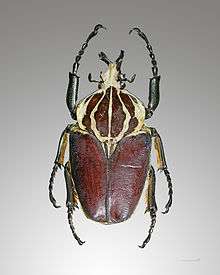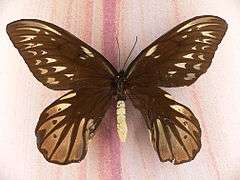List of largest insects


Insects, which are a type of arthropod, are easily the most numerous group of multicellular organisms on the planet, with about a million species identified so far. The title of heaviest insect in the world has many rivals, the most frequently crowned of which is the larval stage of the goliath beetle, Goliathus goliatus, the top size of which is at least 115 g (4.1 oz) and 11.5 cm (4.5 in). The largest confirmed weight of an adult insect is 71 g (2.5 oz) for a giant weta, Deinacrida heteracantha,[1] although it is likely one of the elephant beetles, Megasoma elephas and Megasoma actaeon, or goliath beetles, both of which can commonly exceed 50 g (1.8 oz) and 10 cm (3.9 in), can reach a higher weight.[1]
The longest insects are the stick insects, see below.
Representatives of the extinct dragonfly-like order Meganisoptera such as the Carboniferous Meganeura monyi and the Permian Meganeuropsis permiana are the largest insect species ever known. These creatures had a wingspan of some 75 cm (30 in) and an estimated body weight of over 1 pound (450 g), making them about the size of a crow.
- Cockroaches (Blattodea)
- The largest cockroach is the giant burrowing cockroach (Macropanesthia rhinoceros). This species can attain a length of 8.3 cm (3.3 in) and a weight of 36 g (1.3 oz).
- Beetles (Coleoptera)
- The beetles are the largest order of organisms on earth, with about 350,000 species so far identified. The most massive species are the Goliathus, Megasoma, and Titanus beetles already mentioned. The longest species is the Hercules beetle, Dynastes hercules, with a maximum overall length of at least 16.7 cm (6.6 in) including the very long pronotal horn.The largest fly of the world, Gauromydas heros
- Earwigs (Dermaptera)
- The largest of the earwigs was the Saint Helena giant earwig, (Labidura herculeana), which was up to 8.4 cm (3.3 in) in length.[2]
- True flies (Diptera)
- The largest species of this huge order is Gauromydas heros, which can reach a length of 6 cm (2 1⁄4 in) and a wingspan of 10 cm (3.9 in). The largest species of crane fly, Holorusia brobdignagius, can attain nearly the same wingspan, but if the legs are extended in front of and behind the body, then an overall length of 23 cm (9.1 in) makes it the longest true fly.[3]
- Mayflies (Ephemeroptera)
- The largest mayflies are members of the genus Proboscidoplocia from Madagascar. These insects can reach a length of 5 cm (2.0 in).
- True bugs (Hemiptera)
- The largest species of this diverse, huge order is a giant water bug, Lethocerus maximus. This species can attain a length of 11.6 cm (4.6 in), although it is more slender and less heavy than most other insects of this size (principally the huge beetles).
- Ants, bees, and wasps (Hymenoptera)
- The largest of the ants, and the heaviest species of the family, are the females of Dorylus helvolus, reaching a length of 5 cm (2.0 in). The ant that averages the largest for the mean size of the whole colony is Dinoponera gigantea, averaging up to 3.3 cm (1 1⁄4 in). Another ant that is native to Australia, Myrmecia brevinoda, workers are reported to be 3.7 cm (1.5 in) on average and queens are more than 4 cm (1.6 in) in length.[4]
- The largest of the bee species, also in the order Hymenoptera, is Megachile pluto, the females of which can be 3.8 cm (1 1⁄2 in) long, with a 6.3-cm (2.5-in) wingspan.
- The largest wasp is probably the so-called tarantula hawk species Pepsis pulszkyi, at up to 6.8 cm (2.7 in) long and 11.6 cm (4 1⁄2 in) wingspan, although many other Pepsis species approach a similar size. The giant scoliid wasp Megascolia procer may rival the tarantula hawks in weight, if not length and wingspan. However, the asian giant hornet can reach a body length of up to 2 in.[5]
- Termites (Isoptera)
- The largest of the termites is the African species Macrotermes bellicosus. The queen of this species can attain a length of 10.6 cm (4.2 in) and breadth of 5.5 cm (2.2 in); other adults, though, are about a third of the size.

- Butterflies and moths (Lepidoptera)
- The largest species is probably either the Queen Alexandra's birdwing, Ornithoptera alexandrae, a butterfly, or the Atlas moth, Attacus atlas. Both of these species can exceed a length of 8 cm (3 1⁄4 in), a wingspan of 28 cm (11 in) and a weight of 12 g. Their larvae can weigh up to 58 g (2.0 oz). However, the white witch, Thysania agrippina, has the longest recorded wingspan of the order, and indeed of any living insect, at up to 30 cm (12 in), though it is exceeded in surface area and mass by both Ornithoptera and Attacus.
- Praying mantises (Mantodea)
- Giant shield mantids of the genus Rhombodera can reach lengths of nearly 12cm and are more robust than comparably-sized mantids of other genera (Tenodera, Hierodula, Sphodromantis and Plistospilota.) Some larger species have been known to capture and consume frogs, lizards, mice, small birds, and even snakes. Giant Stick Mantids of the genus Toxodera and Solygia can reach lengths of 20 cm, but are more gracile in build than other large mantids.
- Dragonflies and damselflies (Odonata)
- The largest living species of odonate (the order that includes dragonflies and damselflies) is Megaloprepus caerulatus, attaining a size of as much as 19 cm (7.5 in) across the wings and a body length of over 12 cm (4.7 in). The largest species of dragonfly ever is the extinct Meganeura.
- Grasshoppers, crickets, weta (Orthoptera)
- The largest of this widespread, varied complex of insects is the giant weta, Deinacrida heteracantha, of New Zealand. This formidable insect can weigh over 75 g (2.6 oz) and measure up to nearly 10 cm (3.9 in), rivaling the huge beetles in size.
- Deinacrida heteracantha or Little Barrier Island giant weta, one specimen weighed an atypical 71g [6]
- Stick insects (Phasmatodea)
- The longest known stick insect is Phobaeticus chani, with one specimen held in the Natural History Museum in London measuring 567 mm (22.3 in) in total length.[7] This measurement is, however, with the front legs fully extended. The body alone still measures 357 mm (14.1 in).[8] The species with the second-longest body is Phobaeticus kirbyi, which measures up to 328 mm (12.9 in),[9] while the overall length (from the hind to the front legs) is up to 546 mm (21.5 in),[9] and the body weight is up to 72 g (2.5 oz). The second-longest insect in terms of total length is Phobaeticus serratipes, measuring up to 555 mm (21.9 in).[10]
- Stoneflies (Plecoptera)
- The largest species of stonefly is Pteronarcys californica, a species favored by fishermen as bait. This species can attain a length of 5 cm (2.0 in) and a wingspan of nearly 7.5 cm (3.0 in).
- Booklice (Psocoptera)
- The largest of this order of very small insects is the barklouse of the genus Psocus, the top size of which is about 1 cm (0.39 in).
- Fleas (Siphonaptera)
- The largest species of flea is Hystrichopsylla schefferi. This parasite, known exclusively from the fur of the mountain beaver, can reach a length of 1.2 cm (0.47 in).
- Thrips (Thysanoptera)
- Members of the genus Phasmothrips are the largest thrips. The maximum size of these species is about 1.3 cm (0.51 in).
References
- 1 2 David M. Williams (2001-04-21). "Chapter 30 — Largest Insect". Book of Insect Records. University of Florida.
- ↑ "Labidura". Archived from the original on 2011-02-05. Retrieved 2011-02-05.
- ↑ Carwardine, M. 2008. Animal Records. Sterling Publishing, NY.
- ↑ Wood, Gerald The Guinness Book of Animal Facts and Feats (1983) ISBN 978-0-85112-235-9
- ↑
- ↑ Weta foto
- ↑ "World's longest insect revealed". Natural History Museum. 2008-10-16. Retrieved 2008-10-16.
- ↑ Hennemann, F.H. & Conle, O.V. (October 2008). "Revision of Oriental Phasmatodea: The tribe Pharnaciini Günther, 1953, including the description of the world's longest insect, and a survey of the family Phasmatidae Gray, 1835 with keys to the subfamilies and tribes (Phasmatodea: "Anareolatae": Phasmatidae)" (PDF). Zootaxa. Auckland, New Zealand: Magnolia Press. 1906: 1–316 pp. ISSN 1175-5326. Retrieved 2008-10-16.
- 1 2 Brock, P.D. 1999. The amazing world of stick and leaf-insects. Cravitz Printing Co., Essex, England.
- ↑ Seow-Choen, F. (1995). The longest insect in the world. Malayan Nat. 48: 12.